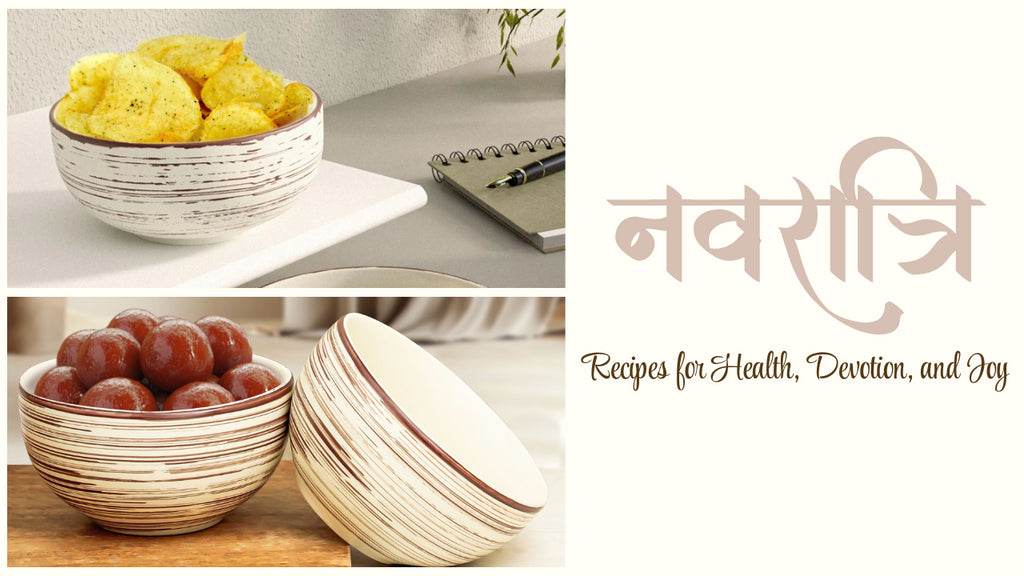A Taste of Tradition: Navratri Recipes for Health, Devotion, and Joy
Posted by MARKETING TES

Navratri, the vibrant and sacred festival celebrated for nine nights and ten days, is a time for devotion, reflection, and celebration. While the spiritual rituals are at the heart of the festivities, the food served during this period also plays a significant role. During Navratri, many people observe fasting or follow a special diet based on specific foods that are allowed during the festival. The dishes are not only delicious but also offer a chance to explore healthy, nutritious alternatives made from locally available ingredients.
In this blog post, we’ll explore some popular Navratri recipes that will allow you to enjoy the festivities while maintaining the spiritual essence of the festival.
1. Sabudana Khichdi (Sago Pilaf)
One of the most popular dishes during Navratri fasting, Sabudana Khichdi is light yet filling, making it a perfect meal during the festival. Made with sago (sabudana), peanuts, and potatoes, it is easy to prepare and provides a quick energy boost.
Ingredients:
-
1 cup sabudana (sago)
-
1 medium-sized potato, boiled and chopped
-
1/2 cup roasted peanuts, coarsely ground
-
2 tablespoons ghee or oil
-
1-2 green chilies, chopped
-
1 teaspoon cumin seeds
-
1/4 teaspoon black pepper
-
Salt to taste
-
Fresh coriander leaves for garnishing
-
Lemon juice (optional)
Instructions:
-
Wash the sabudana thoroughly and soak it in water for 4-6 hours or overnight.
-
Heat ghee or oil in a pan and add cumin seeds. Let them splutter.
-
Add chopped green chilies and the boiled potatoes. Sauté for a couple of minutes.
-
Add the soaked sabudana, ground peanuts, black pepper, and salt. Stir everything together.
-
Cook on a low flame, stirring occasionally until the sabudana turns translucent.
-
Garnish with fresh coriander leaves and a squeeze of lemon juice before serving.
2. Kuttu Ke Aloo (Buckwheat Potatoes)
Buckwheat, or kuttu, is one of the key ingredients during Navratri fasting. It is gluten-free and is often used in rotis and other dishes. Kuttu Ke Aloo is a simple yet flavorful dish made with boiled potatoes, kuttu flour, and aromatic spices.
Ingredients:
-
2 medium-sized potatoes, boiled and cubed
-
2 tablespoons kuttu flour (buckwheat flour)
-
1 teaspoon cumin seeds
-
1/2 teaspoon black pepper
-
1/2 teaspoon red chili powder
-
1 tablespoon ghee or oil
-
Salt to taste
-
Fresh coriander leaves for garnish
Instructions:
-
Heat ghee or oil in a pan. Add cumin seeds and let them splutter.
-
Add the boiled and cubed potatoes to the pan and sauté for a few minutes.
-
In a small bowl, mix the kuttu flour with a little water to form a smooth batter. Add this mixture to the potatoes.
-
Add red chili powder, black pepper, and salt. Stir well to coat the potatoes with the flour.
-
Cook on a low flame until the potatoes are crispy and golden brown.
-
Garnish with fresh coriander leaves and serve hot.
3. Singhare Ke Atte Ka Halwa (Water Chestnut Flour Halwa)
Singhara or water chestnut flour is commonly used during fasting in Navratri. It’s a great alternative to wheat flour and makes for a delicious and nutritious dessert. This Halwa is rich, flavorful, and easy to prepare.
Ingredients:
-
1/2 cup singhare ka atta (water chestnut flour)
-
1/2 cup ghee
-
1/4 cup jaggery or sugar (adjust to taste)
-
1/4 cup milk
-
1/4 teaspoon cardamom powder
-
A few chopped almonds and cashews (optional)
-
A pinch of saffron (optional)
Instructions:
-
Heat ghee in a pan. Add the singhare ka atta and roast it on low flame until it turns golden brown and aromatic.
-
In a separate pan, dissolve the jaggery in warm milk to form a smooth syrup.
-
Slowly add the jaggery syrup to the roasted flour mixture while stirring continuously to avoid lumps.
-
Keep stirring until the mixture thickens and the ghee starts to separate from the halwa.
-
Add cardamom powder and mix well.
-
Garnish with chopped almonds, cashews, and a few strands of saffron before serving.
4. Rajgira Paratha (Amaranth Flour Paratha)
Rajgira (amaranth) flour is a gluten-free option that is packed with protein and fiber. Rajgira paratha is a popular dish during Navratri fasting and is often enjoyed with yogurt or a simple vegetable curry.
Ingredients:
-
1 cup rajgira flour (amaranth flour)
-
1-2 tablespoons ghee or oil
-
Water, as needed
-
A pinch of black salt
-
A pinch of cumin powder (optional)
Instructions:
-
In a mixing bowl, combine the rajgira flour with a pinch of black salt and cumin powder.
-
Gradually add water and knead into a soft dough, similar to regular paratha dough.
-
Divide the dough into small balls and roll them out into flat, round parathas using a rolling pin.
-
Heat a tawa or griddle, and cook the paratha on both sides, applying a little ghee or oil until golden brown and crispy.
-
Serve the paratha hot with a dollop of ghee, yogurt, or a fresh salad.
5. Makhana Kheer (Fox Nut Pudding)
Makhana (fox nuts) are a great source of protein and are commonly used in fasting recipes during Navratri. Makhana Kheer is a rich, creamy dessert made with milk, sugar, and roasted makhanas.
Ingredients:
-
1/2 cup makhana (fox nuts)
-
2 cups full-fat milk
-
2 tablespoons sugar (or jaggery)
-
1/4 teaspoon cardamom powder
-
A few strands of saffron (optional)
-
Chopped almonds and pistachios for garnishing
Instructions:
-
Dry roast the makhanas in a pan until they become crispy. Set them aside.
-
In a saucepan, bring the milk to a boil. Once it starts boiling, reduce the heat to a simmer.
-
Add the roasted makhanas to the milk and cook for 10-15 minutes until the makhanas soften and the milk thickens.
-
Add sugar, cardamom powder, and saffron. Stir well and let it simmer for a few more minutes.
-
Garnish with chopped almonds and pistachios. Serve warm or chilled.
Conclusion: A Feast for the Senses
Navratri is a time to celebrate both spiritually and culturally, and the food we prepare during these nine days plays a key role in connecting us with the festival’s energy and significance. These recipes are not just traditional but also nourishing, offering a variety of flavors and textures that reflect the spirit of Navratri.
Whether you’re fasting or simply enjoying the festive meals, these dishes will add flavor, nutrition, and a sense of celebration to your Navratri. Enjoy cooking, and may this Navratri bring you health, happiness, and divine blessings!


